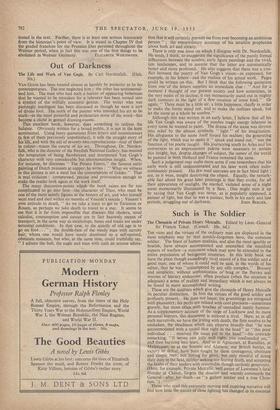Out of Darkness
VAN 'GOGH has been treated almost as harshly by posterity as by his contemporaries. The one neglected him ; the other has sentimental- ised him. The man who had such a horror of appearing bohemian that he wanted to be mistaken for a labourer has been turned into a symbol of the wilfully eccentric genius. The writer who was Piercingly intelligent has been discussed as though he were a sort of divine fool. The work of the painter who intended his art to be stark—in the most powerful and proletarian sense of the word—has become a cliché in genteel drawing-rooms.
This excellent book, however, does something to redress the balance. Obviously written for a broad public, it is not in the least sentimental. Using many quotations from letters and reminiscences (a few of them previously unpublished), it tells the straight story of his life, and with the aid of seventy-two, reproductions—four of them in colour—traces the course of his. art. Throughout, Dr. Norden- falk, who is the director of the Swedish National Gallery, has resisted the temptation of being flamboyant and interpreted Van Gogh's character with very considerable but unostentatious insight. When, for instance, he discusses " The Potato Eaters," the famous early painting of Dutch peasants at supper, he writes : " What we witness in this picture is not a meal but the consumption of fodder." That is real criticism : compressed, precise and provocative enough to make the reader look again at the work itself.
The many discussion-points which the book raises are far too complicated to go into here—the character of Theo, who must be one of the most saintly figures in the history of art, and who himself went mad and died within six months of Vincent's suicide ; Vincent's own attitude to death, " As we take a train to get to Tarascon or Rouen, so perhaps we take death to travel to a star. It seems to me that it is far from impossible that diseases like cholera, renal calculus, consumption and cancer are in fact heavenly means of transport, in the same way as steamships, buses and trains are under terrestial conditions. In that case, to die quietly of old -age is to go on foot ..." ; the double-face of the weedy man with carroty hair, whom, one would have surely dismissed as a self-centred, obstinate nuisance, but who, at the same time, could truthfully say, " I admire the bull, the eagle and man with such an intense adora- tion that it will certainly prevent me from ever becoming an ambitious person " ; the extraordinary accuracy of his intuitive prophecies about both art and society.
There is only one issue on which I disagree with Dr. Nordenfalk. He tends, I think, to exaggerate the significance of the purely formal differences between the sombre, early figure paintings and the vivid, late landsCapes, and to assume that the latter are automatically better and more profound. He also suggests that there was a con- flict between the poetry of Van Gogh's vision—as expressed, for example, in his letters—and the realism of his actual work. Pages could be written on this. But I think that the following quotation from one of the letters supplies an immediate clue : " And for a moment I thought of our present society and how sometimes, in the very midst of its decline, it can momentarily stand, out in mighty dark contours in the light of a flew creation of some kind." Or again, " There must be a little air, a little happiness, chiefly in order to make the forms stand out, and to make the outlines speak, but let the scene as a whole be sombre."
Although this was written in an early letter, I believe that all his life Van Gogh was aware of the sombre tragic energy inherent in every scene he wanted to paint. The drama of the scene was thrown into relief by the almost symbolic " light " of his imagination. His allegiance to the scene itself forced his realism; the generating of the light, which was to make it " speak and stand out," was the function of his poetic insight. His journeying south to Arles and his conversion to an impressionist palette were necessary to sustain this insight, but, despite changes of subject, the nature of the world he painted in both Holland and France remained the same.
Such a judgement may make more sense if one remembers that his early work is still underestimated and his later work often indis- criminately praised. His few mad canvases are in fact blind light ; are, as it were, insight destroying the object. Equally, the remark- able fact about his great later paintings is that they evoke, for all their appearance of sunlight, the startled, violated sense of a night scene momentarily illuminated by a flare. One might sum it up by saying that Van Gogh was never, as is popularly supposed, a painter of light, but that he was a painter, both in his early and late


















































 Previous page
Previous page